Automatically Transfer Excel Data Between Sheets: Simple Guide

Managing data across multiple sheets in Microsoft Excel can seem like a daunting task, especially when you're dealing with large datasets or when you need to ensure data consistency and accuracy. However, Excel offers several methods to streamline this process, allowing for seamless data transfer with just a few clicks or simple formulas. This guide will walk you through various techniques to automatically transfer data between sheets in Excel.
Understanding Excel Sheets and Data Transfer

Before diving into the techniques, let’s briefly cover what Excel sheets are and why transferring data between them is beneficial:
- Excel spreadsheets are organized into sheets, each capable of holding a significant amount of data.
- Transferring data automatically ensures data is up-to-date across different sheets, reducing manual errors and saving time.
- It can facilitate easier management of complex data structures like financial reports, inventories, or project schedules.
Automatic Data Transfer Techniques

Using Excel Formulas

Excel formulas are the simplest way to link data between sheets. Here’s how to set it up:
- Select the cell on the sheet where you want the data to appear.
- Enter a formula like =Sheet1!A1 to reference cell A1 from Sheet1.
- If you need to copy data from a range, use =Sheet1!A1:A10 for cells A1 through A10.
📌 Note: Ensure the sheet name in the formula is spelled correctly. If the sheet name contains spaces or numbers, you must wrap the sheet name in single quotes like ='Sheet 1'!A1.
Power Query

Power Query is a powerful tool for transforming and combining data from various sources:
- Access Power Query: Go to the Data tab > Get & Transform Data > Get Data.
- Select the source, which can include other sheets within the same workbook.
- Create queries to extract and load data into different sheets as required.
VBA Macros

For more complex data manipulation or when you need to automate repetitive tasks:
- Open the VBA Editor: Press Alt + F11 or go to Developer > Visual Basic.
- Insert a new module and write a macro to perform the data transfer. Here’s a simple example:
Sub TransferData() Dim wsSource As Worksheet, wsTarget As Worksheet Set wsSource = ThisWorkbook.Sheets("Source") Set wsTarget = ThisWorkbook.Sheets("Target") wsTarget.Range("A1:A10").Value = wsSource.Range("A1:A10").Value End Sub🔍 Note: VBA macros can interact with other programs or update data sources dynamically, making them incredibly versatile for automation.
Using Named Ranges

Named ranges make formulas easier to read and manage:
- Define a Named Range: Go to Formulas > Name Manager > New, then enter the range name and reference.
- Use the named range in formulas instead of directly referencing cells or ranges.
When to Use Each Method

| Method | Best For |
|---|---|
| Formulas | Simple data linking, direct cell references. |
| Power Query | Advanced data transformation and loading from multiple sources. |
| VBA Macros | Custom automation, complex data manipulation, and integration with other applications. |
| Named Ranges | Clarity in formulas, easier maintenance when changing sheet structures. |

Each of these methods has its place in data management. Choose the one that best suits your needs in terms of complexity, maintenance, and the frequency of data updates.
In conclusion, understanding how to automatically transfer data between sheets in Excel can significantly boost your productivity and accuracy. Whether you're using formulas for simple data links, Power Query for data transformation, VBA for complex automation, or named ranges for clearer formulas, Excel offers multiple ways to manage and streamline your data operations. These techniques empower you to work smarter, not harder, ensuring your data is always accurate and well-organized across your spreadsheets.
Can Excel automatically update data from one sheet to another?

+
Yes, Excel can automatically update data through various methods like formulas, Power Query, or VBA macros, ensuring that changes in one sheet reflect in others instantly.
Is it possible to transfer data between different Excel files?

+
Yes, you can use external links in formulas, Power Query to load data from external files, or VBA to automate data transfer between different Excel files.
How do I keep my formulas from breaking when I move sheets or cells?

+
Using named ranges instead of cell references can help maintain formulas when sheets or cell positions change. Named ranges adapt to the new location automatically.
Can Power Query refresh data automatically?

+
Yes, Power Query can be set up to refresh data automatically when the workbook opens or at set intervals, depending on your Excel version’s capabilities.
What’s the advantage of using VBA for data transfer?

+
VBA allows for complex and customized automation, integration with other applications, and can perform data manipulations not possible with standard Excel functions.



